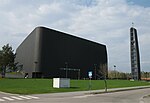Nurmijärvi

Nurmijärvi (Finnish pronunciation: [ˈnurmiˌjærʋi]) is the most populated rural municipality of Finland, located 37 kilometres (23 mi) north of the capital Helsinki. The neighboring municipalities of Nurmijärvi are Espoo, Vantaa, Tuusula, Hyvinkää and Vihti, and it is part of the Greater Helsinki. The population of the municipality is 44,773 inhabitants. In recent decades, it has been one of the fastest growing municipalities in the Greater Helsinki and also in whole Finland in terms of population. The close proximity to Helsinki has led to a considerable growth of the major villages such as Klaukkala, Rajamäki and Röykkä. Klaukkala is the biggest built-up area of Nurmijärvi, which nowadays is considered a dormitory town of Helsinki. The Nurmijärvi church village (Kirkonkylä) is the administrative centre of the municipality, although the clear emphasis on population growth is in Klaukkala. Nurmijärvi literally means "lawn lake" although the lake that gave the municipality its name was drained in the early 20th century and is now nothing more than some flat fields near the village centre. Nurmijärvi is one of three municipalities in the Uusimaa region that do not have a Swedish name; the others are Askola and Mäntsälä. Matti Vanhanen, former Prime Minister of Finland, lives in the Lepsämä village in Nurmijärvi.
Excerpt from the Wikipedia article Nurmijärvi (License: CC BY-SA 3.0, Authors, Images).Nurmijärvi
Sairaalantie, Helsinki sub-region
Geographical coordinates (GPS) Address Phone number Website Nearby Places Show on map
Geographical coordinates (GPS)
| Latitude | Longitude |
|---|---|
| N 60.466666666667 ° | E 24.808333333333 ° |
Address
Tokmanni
Sairaalantie 3
01900 Helsinki sub-region, Toreeni
Finland
Open on Google Maps











